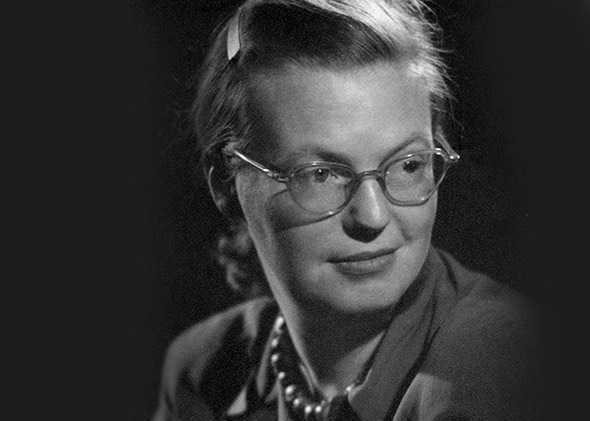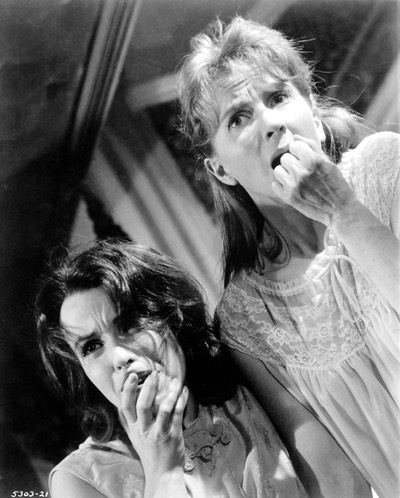The opening lines of Shirley Jackson’s masterpiece set the mood:
No live organism can continue for long to exist sanely under conditions of absolute reality; even larks and katydids are supposed, by some, to dream. Hill House, not sane, stood by itself against its hills, holding darkness within; it had stood so for eighty years and might stand for eighty more. Within, walls continued upright, floors were firm, and doors were sensibly shut; silence lay steadily against the wood and stone of Hill House, and whatever walked there, walked alone.
It was 1959, eleven years after the appearance of her gripping short story “The Lottery,” that Jackson hit her stride with The Haunting of Hill House. Her distinctive use of dramatic tension based on character, stress, and dread drove the story, and the novel’s long form was both ambitious and compelling. To this day, readers glance up from its pages to check a room’s dark corners. Some, when alone, soon put the book down until they have someone else in the house. At least, someone else they know is supposed to be there.
It was an unlikely book to catch on. The basis for the story is formulaic, the sort of thing routinely pitched with one line at a movie studio: “haunted house terrifies inhabitants.” And in most of these stories the reason people stay in a “haunted” house is pretty tired in itself. Motivations are simplistic, as when characters willingly place themselves in peril to collect an inheritance or win a wager. Usually writers provide for a goodly number of these people so when they start disappearing — the gloved hand reaches around the potted palm and Millicent or Daphne exits the story, disappearances that frighten those who remain — there’ll be enough of them to carry the plot to a conclusion. It’s the stock and trade of the horror genre along with the car that won’t start, running from the bad circumstance to the worse, and the victim who hasn’t a shred of peripheral vision.

Shirley Jackson
The genius of Shirley Jackson, however, was in her using these conventions while defying them. She reduced her cast to a mere four people and set the situation for their interactions in a bewildering house with a sordid past and dark reputation. Even so, the reason for their being there is something of a stretch at first. A legitimate researcher of the paranormal plans to examine the functions of a “haunted house” by recruiting people uniquely qualified to observe them. But it gradually becomes apparent that each of these people, including the credentialed researcher, is psychologically vulnerable. His scientific bona fides turn out to be less important than a troubled personal life. Likewise, the clairvoyant he recruits as part of the observation team is named Theodora and called “Theo,” which hints at a muddled sexuality that inclines toward lesbianism that in 1959 made her an outsider. Theo’s cynicism and acerbic manner grates on the other members of the team, especially mild-mannered Eleanor, a pleasant woman pushing middle age and certain spinsterhood. She has been recruited because she experienced an extraordinary, inexplicable paranormal event as a child, but it turns out that Eleanor also harbors seething resentments toward her family and bears a crushing guilt because she hates them. Rounding out the group is the youthful heir to Hill House, a twenty-something highly amused by all the supernatural nonsense and at first present for no other reason than to protect his investment.
Jackson pits these flawed people against a formidable opponent in Hill House, which is unsettling because it is never really clear if there is actually something evil in Hill House or if the people themselves are the problem as they try to “exist sanely under conditions of absolute reality.” They must rely on courage and resolve, especially during the night, for it is in the night, as the housekeeper tells them as she departs for town at sunset, when nobody will be able to hear them, or help them.
Hollywood has told this story twice, but the attempt in 1999 completely missed the point with gaudy special effects that turned Shirley Jackson’s psychological thriller into a bombastic bomb. Far superior is the simpler and truly terrifying movie made in 1963. Robert Wise directed the The Haunting, and he wisely consulted Jackson about plot, place, and people. He had originally intended to make a complicated story about mental illness, focusing on the possibility that what happens at Hill House is a sort of collective insanity. Instead, Wise followed her advice to make a classic horror story, and as a result the film is quite faithful to the book. His depiction of Hill House used high contrast black-and-white photography to make it overpowering as well as forbidding, and the studio sets for the interiors were heavily shadowed and shot with unsettling camera angles to suggest something is sleeping, watching, waiting, choosing its time.
The titular house becomes as much a star as the players, but the actors capture perfectly Jackson’s characters, especially Julie Harris as the fragile Eleanor. She was reportedly disappointed with her performance, but her frailty is powerful, and Eleanor’s occasional outbursts of bad temper can turn her from mouse to manipulator in an instant. Everyone is quite good, in fact, and though forced into the role by a contract dispute, Russ Tamblyn as the flippant young man builds a character whose initial skepticism about the experiment makes what happens during the story even more disturbing.

Theo and Eleanor
And it is disturbing. It is very disturbing. No floating ghosts wisp about, no visual effects assault the eye with standard "haunted house” fare, nothing slashes, and no one bleeds, but prepare youself for a deliciously terrifying psychological experience framed by noise, suggestion, and inference. In one scene Eleanor and Theo huddle in their isolated bedroom as they listen to a distant, rhythmic pounding. Something seems to be violently striking a distant wall of the house. Yet, the pounding begins to come nearer, recedes, then again renews its slow and steady approach, as it it’s searching. They hear it increasing to an ear-shattering volume that shakes their room as it moves down the hall toward their door. All goes quiet. The doorknob moves slightly. Eleanor’s voice is flat and almost matter-of-fact when she says, “It’s found us.”
The question remains what “it” is, which is the real terrifying power of Hill House and the haunting that purports to infest it. Is it in the minds of these people? Or is it something in the house that mounts a horrible cerebral assault on their senses? Could the house itself be evil, something more than an architectural oddity where doors remain sensibly shut because their jambs are deliberately out of plumb? It is, after all, a place of the night, and whatever walks there, walks alone.
Shirley Jackson died a couple of years after the premier of The Haunting. For all her life, the mind able to conjure fear in the ordinary and make stories of dread wickedly entertaining was plagued by troubled thoughts. She took a variety of medicines to cope, and one night she simply went to sleep and didn’t wake up. Her heart had given out, they said. Shirley Jackson was 48. It had found her.